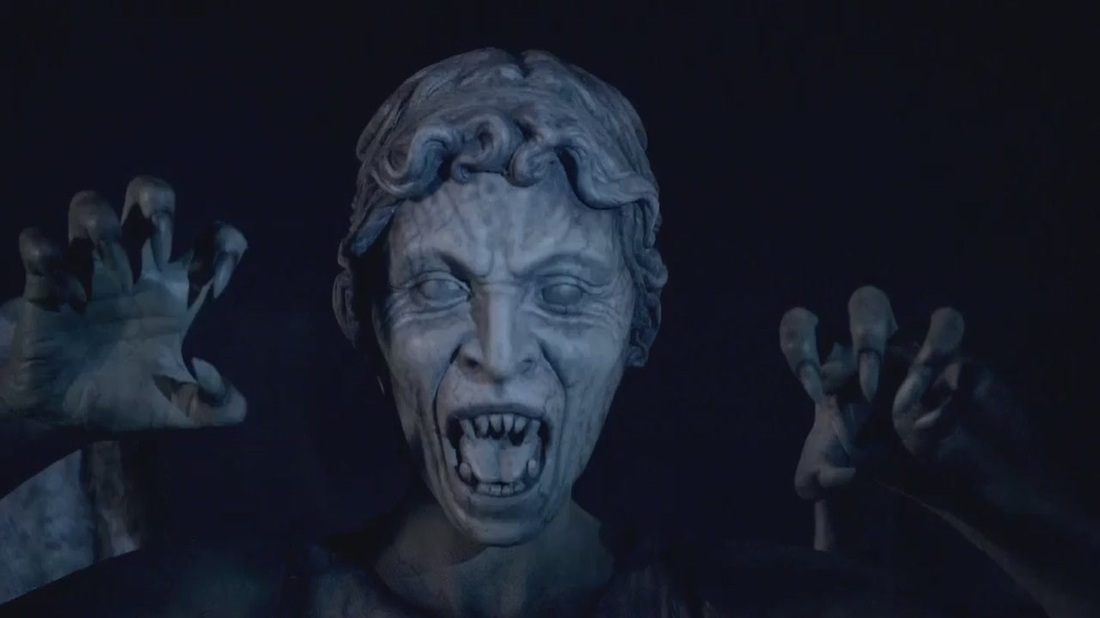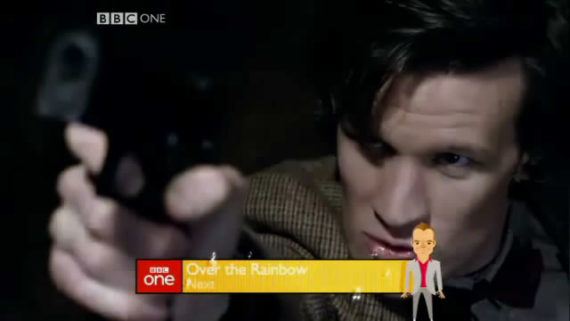Otherwise known as the Lonely Assassins, the Weeping Angels are some of the scariest monsters in the Whoniverse.

The Weeping Angels made their first appearance in Doctor Who in the 2007 episode ‘Blink.’ Written by Steven Moffat, they take the appearance of static stone statues. The reason for this is simple – they are unable to move so long as they are being looked at. This is why they constantly cover their eyes; if the Weeping Angels were to look at each other (or in a mirror) for even a second, they’d be permanently paralysed.
This is something of a comfort to those who are hunted by the so-called Lonely Assassins. But it’s no guarantee of safety. The paralysis can be broken if a person blinks, or even if they look a way for a moment. The Weeping Angels are swift movers, and can kill a person in an instant.
Well, “in an instant” may not be entirely accurate. Whilst it’s true that these baddies can leap on their prey at lightning speed, it usually takes the victim a long time to die. This is because the Weeping Angels usually feast on people by sending them back in time, and feeding off the days that they never had. And so to “die” at the hands of a Weeping Angel is actually a slow death.
Indeed, in ‘Blink’ the Doctor and his companion Martha fell foul of an attack by the Weeping Angels. Finding themselves stranded in the 1960s, the pair were forced to concoct an elaborate plan that enabled the Doctor to communicate with a woman called Sally Sparrow via a DVD Easter egg.
It may sound crazy (and possibly one of the most timey-wimey episodes of Doctor Who of all time) but it worked. Moreover, ‘Blink’ proved to be immensely popular with Doctor Who fans, and in a 2009 poll to find the best story ever, it came in second place after the 1984 story ‘The Caves of Androzani.’ In addition, Steven Moffat won the BAFTA Craft and BAFTA Cymru awards for Best Writer, and the Hugo Award for Best Dramatic Presentation, Short Form.
As such, the Weeping Angels’ place in the pantheon of classic Doctor Who monsters was assured. The baddies went on to appear as the main adversaries in two further stories, leaving a trail of destruction in their wake.
The first of these was 2010’s ‘The Time of Angels’ and ‘Flesh and Stone,’ written once again by Steven Moffat. The adventure concerned a crashed spaceship called the Byzantium, which was teeming with Weeping Angels. And this time, the Doctor had more than just blinking to worry about, as it was established that images of Angels could, themselves, become Angels. This proved problematic for the Doctor’s companion Amy who, after watching some footage of one of the creatures, ended up with a Weeping Angel inside her eye, forcing her to walk through the Byzantium with her eyes shut to stop it from killing her.

At the same time, the Doctor found that he was able to communicate with the Weeping Angels directly via radio, the Angels having made this possible by stripping the cerebral cortex of a soldier named Bob and reanimating his consciousness. The result was a somewhat disturbing interaction between the Doctor and a calm-sounding Northerner who explained, in cool, clinical terms, that he intended to kill them all.
And whilst ‘The Time of Angels’ had a relatively happy outcome, the same could not be said for the subsequent story ‘The Angels Take Manhattan,’ which was an altogether more devastating affair. In the adventure, the Doctor, Amy and Rory arrived in modern day New York only to discover that the Weeping Angels had taken over an apartment complex known as Winter Quay. They were using the building like a larder, sending people back in time and keeping them contained within its four walls, feeding off the residual time energy.
This had devastating consequences for Rory, who discovered his own aged body within Winter Quay. Rory quickly realised that the Weeping Angels would be sending him back in time imminently, and the only way to avoid this fate would be by throwing himself off the roof of the building. This “death” made it impossible for him to die as an old man, creating a paradox that destroyed the entirety of Winter Quay and its Angels.
Even then, the TARDIS team were not in the clear. (Spoiler warning.) In the episode’s final moments, as the Doctor and his friends are preparing to leave in the TARDIS, Rory is attacked by a Weeping Angel and sent back in time. Rescuing him is impossible; if the TARDIS were to go back and save him, the paradox would tear New York apart. As a result, a desperate Amy concludes that the only way she will be able to see her husband again is by allowing the Angel to attack her too, and send her back to the same time zone as Rory.
Obviously, the Doctor is strongly against this idea – there is no guarantee that Amy will end up in the same place as Rory, and even if she does, she will never be able to see the Doctor again. But despite the protestations, Amy turns her back on the Weeping Angel and allows herself to be sent back in time. A devastated Doctor looks on as her name appears on a nearby gravestone, next to her husband’s.
So as you can probably tell, the Weeping Angels are not to be trifled with. But will the Doctor ever meet them again? It’s certainly possible. They have made a number of surprise cameos over the years, most recently in the 2021 episode ‘Revolution of the Daleks.’ We could be seeing them much sooner than we think.
Do you think the Weeping Angels will make a return appearance in Doctor Who Series 13? And what is your favourite adventure featuring these iconic baddies? Let me know in the comments below.

Doctor Who gloves for women – order now from the Lovarzi shop!

Leave a Reply